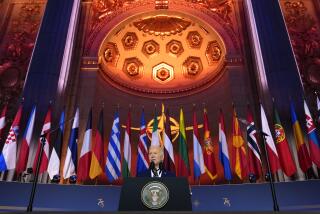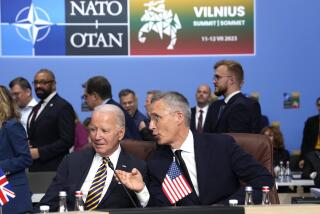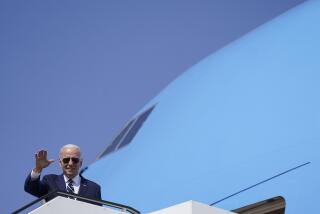Global Alliances Shifting From Political to Economic : Transition: Trade is the new glue that binds nations, playing a bigger role in shaping world events.
- Share via
WASHINGTON — The Warsaw Pact is history, and NATO may take in some of its former East European foes. The end of U.S.-Soviet rivalry has left the 101 nations of the Non-Aligned Movement with virtually nothing to be “non-aligned” against. The Arab League fell apart during the Persian Gulf conflict, and the unwinding of apartheid in South Africa has robbed the Organization of African Unity of the one issue on which its otherwise fractious members agreed.
Around the world, many of the traditional political and military alliances that have defined the pattern of international relations over the past half-century are now struggling with fundamental questions of identity and mission.
In their place, a growing number of economic alliances--some loose groupings, others formal blocs--are playing an increasingly important role in shaping global events. The trend has gained such momentum over the past two years that many countries are scrambling to form new alliances, expand existing blocs or revive old ones.
“The new economic alliances taking form and the new economic linkages between countries are changing the very way we look at the world,” said Robert Z. Lawrence, a Harvard professor of international trade.
“There’s a mentality now that a country has to be a member of a bloc to survive,” observed Alexander Yeats, a World Bank specialist on the new alliances.
Altogether, at least 17 common markets and free trade areas are currently working to advance the economic interests of their members--sometimes at the expense of other countries or regions. And dozens of other alliances address specific aspects of international trade and cooperation.
The line-up of new alliances is diverse. The Southern Cone Common Market, also known as MERCOSUR, last year brought together Argentina, Brazil, Paraguay and Uruguay. The new Black Sea Economic Cooperation Accord last month formally joined Turkey with Russia and seven other former Communist neighbors. In Central Europe, the Hexagonal brought together Italy, Austria, Hungary, Czechoslovakia, Poland and Yugoslavia in 1991.
Even feistily independent Iran, virtually isolated since its 1979 revolution, has joined the merger frenzy. Last month, President Hashemi Rafsanjani announced the formation of the Economic Cooperation Organization, grouping Iran, Turkey, Pakistan and five former Soviet Asian republics. Once the Afghan crisis is settled, ECO hopes that the Kabul government will also join.
The new bloc, already nicknamed the “Islamic Common Market,” brings together 250 million people from the Balkans to the Himalayas. Rafsanjani boldly, although perhaps prematurely, predicted that ECO’s resource-rich members would become “an important weight in the global economy.”
In some cases, the effort to enhance economic linkages is uniting former rivals. In Washington last month, Zambian President Frederick Chiluba called for expansion of a 20-member African alliance known as the Preferential Trade Area to include South Africa. “After apartheid, I see a strong economic bloc emerging on my continent,” Chiluba said.
Experts say the trend toward regionalization over the past 40 years reflects a fundamental shift in perceptions of the primary mission of the state.
“For hundreds of years, nations have concentrated on geographic or territorial space. That was the highest calling of statecraft,” said Gary Hufbauer, professor of international financial diplomacy at Georgetown University. “In the postwar era, it dawned on people that you don’t need to acquire territory to have economic space. You can have it by developing a vibrant economy with very little space, like Hong Kong or Japan.”
Because the arena of competition has changed, so, too, has the nature of alliances. While military and territorial blocs are not expected to disappear, experts agree that they will diminish in importance. “The number and size of corporations will be more important than the number or size of battalions,” Hufbauer said. “The level of foreign trade will be more important than the level of military budgets.”
Although economic blocs come in many shapes and sizes, they tend to be packaged in one of three basic forms.
Some are common markets, with unfettered free trade among member nations that, in turn, have common trade and tariff barriers with the outside world.
The European Community is the ultimate model of a common market. But the Maghreb Union, which united Algeria, Libya, Mauritania, Morocco and Tunisia in 1989, also aims at total economic integration.
Others are free trade areas that feature duty-free trade among members, but allow each country to determine its own rules on trade with the rest of the world. The North American Free Trade Area, for example, eventually may group the United States, Canada and Mexico in that fashion.
Common markets and free trade areas account for almost 60% of world trade and manufacturing, according to a new World Bank study.
The third type of bloc involves alliances that encourage common projects and planning between members on issues such as economic development, environmental problems and information links. While more numerous, these blocs generally lack tight structure and still have some barriers to free trade among members.
Iran, again, offers a new example. On the same day that the Islamic Common Market was born, Tehran also announced creation of the Caspian Sea Pact. It brings together the five states on the world’s largest inland lake to cooperate on economic and environmental issues.
Economic alliances do not necessarily involve neighboring countries or conform to regional boundaries. The United States and Israel have duty-free trade, for example, a relationship based more on political than on economic priorities.
The 15 members of the Asia-Pacific Economic Cooperation agreement include such distant nations as Brunei and the United States, South Korea and New Zealand. Launched in 1989 to promote multilateral cooperation, APEC addresses topics ranging from trade promotion to marine conservation.
Besides the different forms they take, blocs are at widely divergent phases of development. “Some are intact, some are evolving and some are only wishful thinking,” said Jeffrey J. Schott, a bloc expert at the Institute for International Economics in Washington.
Some, like the Southern Cone, may take years to grow into meaningful coalitions. Others, such as the new Islamic bloc, could take a generation or more to develop--if they survive at all.
Virtually all blocs, however, have a common denominator: “The residue of the debt crisis and the difficulty of competing in world markets has forced countries to realize they have to make better use of resources and join forces with their neighbors, near or far, in common pursuit of improved trade,” explained Schott.
Not all blocs are new. In fact, many were created in the 1960s and 1970s, during the last rush to regionalize; others are even older.
The 16 members of the Economic Community of West African States, or ECOWAS, came together in 1975. The Caribbean Community and Common Market, or Caricom, grouped 13 island-states in 1973.
After the initial enthusiasm, however, several alliances drifted into inertia; some eventually fell apart.
The most common problem, particularly among developing countries, has been unequal distribution of economic benefits among members. The East African Community broke up in 1977 because Kenya reaped benefits--from investments, joint ventures, even communal airline revenues--at the expense of Uganda and Tanzania.
Another problem has been a lack of industrial power. That is one of the reasons Africa has found it difficult to forge viable blocs. It also helps explain why black African states are now interested in integrating South Africa, the continent’s most advanced industrial state.
A third problem has been the divergent agendas of individual countries participating in alliances.
“The ASEAN (Association of Southeast Asian Nations) countries--Singapore, Indonesia, Thailand, Malaysia, Brunei, the Philippines--are at the highest level of industrialization in the developing world,” said Yeats, the World Bank specialist. “But that still hasn’t made it a successful bloc. National priorities have kept these countries apart.”
In other cases, alliance participants are mismatched, sometimes because they have too many products in common and sometimes because they have wide disparities in income and capabilities.
Virtually all the older blocs are in the process of refocusing or reinvigorating their missions.
The ASEAN countries, for example, are discussing free-trade agreements in serious terms for the first time in years. Scandinavian countries are talking about putting more muscle into the Nordic Council, a looser alliance that first brought together Denmark, Finland, Iceland, Norway and Sweden in 1952. And three former Soviet republics have revived the Baltic Council, first formed in the 1930s.
Schott said that blocs require four basic characteristics to be successful: geographic proximity, similar or compatible trading regimes, political commitment to regional organization and similar levels of per-capita economic output.
Blocs that have survived since the last rush to regionalize also tended to start out small, according to Georgetown’s Hufbauer.
The mighty European Community grew out of the relatively innocuous European Coal and Steel Community, formed in the 1950s. The roots of the U.S.-Canada free trade arrangement, the forerunner to NAFTA, are found in bilateral pacts on automobiles forged in the mid-1960s.
Over the next decade, experts say that economic alliances in the developing world face the greatest pitfalls.
“The depth of integration in these arrangements varies dramatically,” said Harvard’s Lawrence. “And there’s reason to be skeptical of the depth of commitment that varying parties will be able to show. They believe they have to get together, but whether they can really pull it off is another question.”
Some blocs may group politically or culturally compatible nations, but not economies that will necessarily thrive together.
“The Islamic bloc is likely to find the former Soviet republics a trap, not an opportunity. They need a lot, and Iran has its own postwar recovery program to worry about, while Turkey also has no money,” said Mark Lowenthal, senior foreign policy analyst at the Congressional Research Service.
“And the Black Sea bloc?” Lowenthal continued. “What do they offer? What’s the basis of their power except that they’re a bloc of similarly situated states? Besides, who cares?
Some blocs in Latin America, in contrast, may offer more possibilities because their members have industrialized societies, better-educated populations and economic wherewithal.
One unusual “bloc” was specifically designed to overcome the problems faced by developing nations. Launched in the late 1980s, the Global System of Trade Preferences (GSTP) provides a framework for trade among distant countries in the Southern Hemisphere, largely to get around the problem of similar products and produce among neighboring countries. Under the GSTP, goods produced in African states can be exported to countries in Asia and Latin America at lower tariffs.
But whatever the problems, the economic incentives to form new blocs and expand old ones is not likely to diminish, experts say. And alliances based primarily on economics may generate constructive political and military byproducts.
The Maghreb Union in North Africa, for example, grew out of rapprochement between Algeria and Morocco after years of conflict over the Spanish Sahara. The union has helped keep peace efforts on track.
And the new Islamic bloc may promote cooperation rather than confrontation between Turkey and Iran over influencing the fate of the five Islamic states after more than a century of Russian colonization.
The future of existing blocs--and the potential formation of new ones--may depend in part on the outcome of long-stalled talks on the General Agreement on Tariffs and Trade, an attempt to remove tariff barriers globally.
Yet many U.S. and foreign economists contend that economic alliances have gone too far to be simply dissolved. “Blocs are here to stay, even if there is a GATT arrangement,” said Carlos Braga, a Brazilian economist and bloc expert.
Where Trade Is the Common Coin
Although scores of economic alliances have been formed throughout the world, only 17 are considered to be true common markets or free trade areas. Here are some of the main ones:
Andean Group
Members: Bolivia, Colombia, Ecuador, Peru, Venezuela
Formed: 1969
Combined population: about 92 million.
ASEAN (Assn. of Southeast Asian Nations)
Members: Brunei, Indonesia, Malaysia, Philippines, Singapore, Thailand
Formed: 1967
Combined population: about 333 million
EC (European Community)
Members: Belgium, Denmark, France, Germany, Greece, Ireland, Italy, Luxembourg, Netherlands, Portugal, Spain, Britain
Formed: 1957
Combined population: about 345 million
ECO (Economic Cooperation Organization)
Members: Azerbaijan, Iran, Kyrgyzstan, Pakistan, Tajikistan, Turkey, Turkmenistan, Uzbekistan
Combined population: more than 250 million
ECOWAS (Economic Community of West African States)
Members: Benin, Burkina Faso, Cape Verde, Gambia, Ghana, Guinea, Guinea-Bissau, Ivory Coast, Liberia, Mali, Mauritania, Niger, Nigeria, Senegal, Sierra Leone, Togo
Formed: 1975
Combined population: about 206 million
GCC (Gulf Cooperation Council)
Members: Bahrain, Kuwait, Oman, Qatar, Saudi Arabia, United Arab Emirates
Formed: 1981
Combined population: about 23 million
LAIA (Latin American Integration Assn.)
Members: Argentina, Bolivia, Brazil, Chile, Colombia, Ecuador, Mexico, Paraguay, Peru, Uruguay, Venezuela
Formed: 1980
Combined population: about 380 million
NAFTA (North America Free Trade Area)
Members: Canada, Mexico, United States
(U.S.-Canada trade area formed in 1989; agreement with Mexico under negotiation)
Combined population: about 365 million
Sources: Alexander Yeats and Carlos Braga at the World Bank, Robert Lawrence at Harvard University’s John F. Kennedy School, The World Almanac 1992, Reuters, and Times researchers Aleta Embry and Nancy Shiner.
More to Read
Sign up for Essential California
The most important California stories and recommendations in your inbox every morning.
You may occasionally receive promotional content from the Los Angeles Times.













